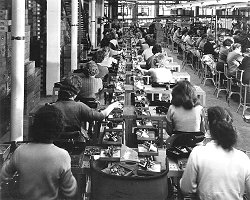-edible zone-
No.6435 Overview
Starting Line
Arrival Deconstruction
Beneath Decks
First Night's Spin
Listening to Plinths
Motor
System:The Tonearm Tweaks
Articles
Bookshelf Transit
*
FIRST NIGHT spinning.
By the time I got thru the
woodwork, the lube-factory, the arm-placement and all the rest, I
realized I had mounted the arm so that it’s VTA tower conflicted with
the counterweight’s travel in the course of tracking a complete record.
Uncharacteristically, but wisely, I decided against going well into the
late evening to remount the arm and gave it up for that day.
SECOND NIGHT, Really spinning.
By the next afternoon I was
playing records, and I thought I deserved to give it a grueling maiden
run. I attached and aligned an average moving-magnet cartridge, plugged
into an average solidstate phono preamp, and that out to a small
solidstate powered monitor speaker…. basic bench-test mono.
For
the first run, I chose a record both for it's
garden-variety-nothing-special Lp sound, and also for it's
less-than-perfect condition. With a little relief I found that there was
an undeniable impact thing happening, even with an average-to-noisy copy
of the Stones doing “If You Can’t Rock Me” on the live recording 'Love
You Live’ from 1977.
This was not about bass extension or
something like that, and I wouldn’t have heard that in this bare-bones
monitoring setup anyway. This was about pace, drive, and punch. Time, in
fact-- all about Time. Which is intrinsically necessary to getting life
out of an old live set, something hopefully representative of what about
a dollar buys at a used record shop. I was glad to be going with this
least-common-denominator setup to hear this table on it’s first spin in
years, since it pretty well validated itself on the first couple of
rotations.
By now I was coming to a theory. My theory is that,
in the hype-driven rush to ‘signal-to-noise’ supremacy, belt-drive
technology suspended and isolated each element in the transport at such
a remove that it may have just pulled the rug out from under itself.
When motors and platters ( read : engine and load ) are separated with
indiscriminate respect to speed stability, then the credibility of the
transport system is at risk. Yes, with beltdrive, there is a deathly
black silence between consequently monumental and percussive sonic
events, but….
If there already exists the least divergence from
ironclad speed control, any advance on the signal-to-noise front is a
chimera. Time, and Time above all, is the central and non-negotiable
responsibility of the transport. Failing that, other “hi-fi”
considerations are, well, lipstick on a pig.
In the course of the
evening I moved from thick seventies rock to ultra-produced eighties &
nineties pop and then backwards to late fifties jazz… I also moved, a
step at a time, first to a real amp and large speakers, and by late at
night to the ‘real’ phonostage and all-tube system.
By this time
I gave up on being objective, and having consumed a few buckets of
cabernet, I was completely convinced this was a promising project. Even
still, I knew I was light-years away from getting it into the league of
more refined program material, say, Scarlatti da camera, or Correlli da
chiesa.
Next up : Benchwork - time to get a little more
elaborate with the plinth.
*
LUBE TYPES Used.
Spindle bearing grease : Ultra Lube Multi
Purpose Grease, Plews-Edelman
Sewing Machine Oil : Zoom Spout Sewing
Machine Oil
Linkage Grease : White Lithium Grease, Panef Corp.
Motor Bearing Oil : Extendo All Purpose Motor / Bearing Oil, Sid Harvey
Motor Bearing Oil : 3-In-One SAE-20 Elecric Motor Oil
Cleaning Solvent : Zippo Premium Lighter Fluid, Zippo Manufacturing Co.
If by chance the above sounds a little 'authoritative' --- don't
believe it for a minute. Although I've read every last thing I can find
on this for several years running, I've still got no certain idea of
exactly what's to be done from one step to the next. That's encouraging,
huh ? I guess no single 301/401 project needs to be definitive as long
as several individual approaches make it to the Internet, and anybody
who wants to can plan their own from there .....
The
groundbreaking article for most of us on the 301 / 401 was Haden
Boardman’s original “Turning The Tables” in Sound Practices of Spring
1994, which neatly set the general outlines. A much later article by
Jonathon Noble “Diy-ing A Time Machine” was written in 2004 and gets to
the reason why-- very well indeed. Both available on the internet.
James Donahue, 2006

Assembly Line At Garrard in Swindon